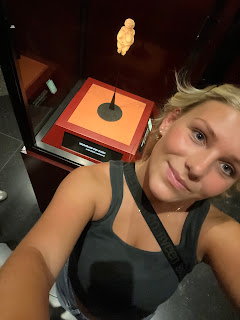Vienna-Natural History Museum
Today we visited the natural history museum. I must admit, I am not typically a science girl. It just does not spark my interest. However, gazing around the rows of stones and meteors, fossils and statues, and taxidermied animals was interesting. I decided to focus my writing today on the Venus of Willendorf figurine. I was very excited to see her in person because I learned about her in my Western Humanities class last semester. It was pretty surreal seeing the real thing. What shocked me was her size! She was about 4 inches tall and tiny! She was cream with large breasts and a full stomach.
The figure is extremely important historically. It is ancient, dating back to around 28,000 to 25,000 BCE. The figurine was discovered in Austria in 1908. Her figure has dramatized female features, including a large stomach and big breasts, thought to symbolize the "ideal" body type for a woman during the Stone Age. Though some disagree, she is commonly known to symbolize fertility and motherhood. Her face is absent from distinct features, making her body the center of attention, and highlighting her symbolism. The figurine is an extremely interesting example of prehistoric art which gives us an insight into the customs of the Stone Age.
This figurine contributes to Vienna status as cultural capital for a couple reasons. The fact that it has survived this long is nothing short of amazing. It provides visitors with an insight into the prehistoric past. It allows us to learn about the early human experience by learning about its association with rituals and symbols. I think the natural history museum is a great institution that Vienna claims. It shows a city's intelligence but showcasing their scientific findings. The Venus of Willendorf is something taught in classes that was really important in the Stone Age, an artifact I am so grateful to have seen in person!




Great post! I like how you mentioned how it helps us learn about early human experience. That as well as preserving knowledge I think contributes to a cultural capital. And yes the Venus of Willendorf was so cool and it brings us art and culture from the past!
ReplyDeleteI love your post, Laynee! I think you do a great job explaining how the Natural History Museum is used to strengthen Vienna’s status as a cultural capital. the Venus of Willendorf artifact that they have on display there helps us understand early human rituals and societal norms. Vienna’s commitment to preserving and displaying artifacts like the Venus of Willendorf highlights how important and deep Vienna’s history is to the city and its country.
ReplyDeleteKiller post, Laynee!! I agree that it's so impressive we still have a lot of these really old artifacts! I was also equally as excited to see Venus of Willendorf! I like how you said that it is a reflection of the intelligence of the city itself, by having scientific findings and preserving them means that it's important to them as a people and as a cultural capital. It's also important, like you said, that it gives us a glimpse into the past. As we learn from the past, we can make a better future.
ReplyDeleteLoved this post, Laynee! I like how you talked about how this museum allows us to learn more about early humans and their life, especially in Vienna. That has such an impact on the city and its status as a cultural capital!
ReplyDelete